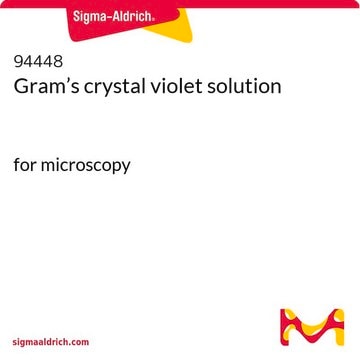61135
Crystal Violet
for microscopy (Bact., Bot., Hist., Vit.), indicator (pH 0.1-2.0)
Sinonimo/i:
Basic Violet 3, Gentian Violet, Hexamethylpararosaniline chloride, Methyl Violet 10B
About This Item
Prodotti consigliati
Grado
for microscopy (Bact., Bot., Hist., Vit.)
indicator (pH 0.1-2.0)
Livello qualitativo
Forma fisica
powder
Colore
green to very dark green
visual transition interval
0.1-2.0, yellow-green to blue-violet
Punto di fusione
205 °C (dec.) (lit.)
Densità
1.190 g/cm3
ε (coefficiente d’estinzione)
≥1750 at 585-595 nm in water
Compatibilità
suitable for microscopy (Bact., Bot., Hist., Vit.)
Spettro attività antibiotica
fungi
applicazioni
diagnostic assay manufacturing
hematology
histology
Modalità d’azione
cell membrane | interferes
enzyme | inhibits
Temperatura di conservazione
room temp
Stringa SMILE
[Cl-].CN(C)c1ccc(cc1)\C(c2ccc(cc2)N(C)C)=C3/C=C\C(C=C3)=[N+](/C)C
InChI
1S/C25H30N3.ClH/c1-26(2)22-13-7-19(8-14-22)25(20-9-15-23(16-10-20)27(3)4)21-11-17-24(18-12-21)28(5)6;/h7-18H,1-6H3;1H/q+1;/p-1
ZXJXZNDDNMQXFV-UHFFFAOYSA-M
Cerchi prodotti simili? Visita Guida al confronto tra prodotti
Categorie correlate
Descrizione generale
Applicazioni
- Crystal violet is mainly used in Gram staining and its variants, and for staining amyloid, bacterial components, and vascular plant tissues.
- It is used in polychrome staining of epoxy resin sections, viability staining of cultured neurons, and confocal optical sectioning to analyze meiotic structures.
- It is also employed in the acridine orange-crystal violet staining of intracellular bacteria, microsporidian spores, and cytological smears.
Azioni biochim/fisiol
Principio
Avvertenze
Danger
Indicazioni di pericolo
Consigli di prudenza
Classi di pericolo
Acute Tox. 4 Oral - Aquatic Acute 1 - Aquatic Chronic 1 - Carc. 1B - Eye Dam. 1 - Muta. 2
Codice della classe di stoccaggio
6.1C - Combustible acute toxic Cat.3 / toxic compounds or compounds which causing chronic effects
Classe di pericolosità dell'acqua (WGK)
WGK 3
Punto d’infiammabilità (°F)
Not applicable
Punto d’infiammabilità (°C)
Not applicable
Dispositivi di protezione individuale
Eyeshields, Faceshields, Gloves, type P3 (EN 143) respirator cartridges
Choose from one of the most recent versions:
Possiedi già questo prodotto?
I documenti relativi ai prodotti acquistati recentemente sono disponibili nell’Archivio dei documenti.
I clienti hanno visto anche
Il team dei nostri ricercatori vanta grande esperienza in tutte le aree della ricerca quali Life Science, scienza dei materiali, sintesi chimica, cromatografia, discipline analitiche, ecc..
Contatta l'Assistenza Tecnica.








